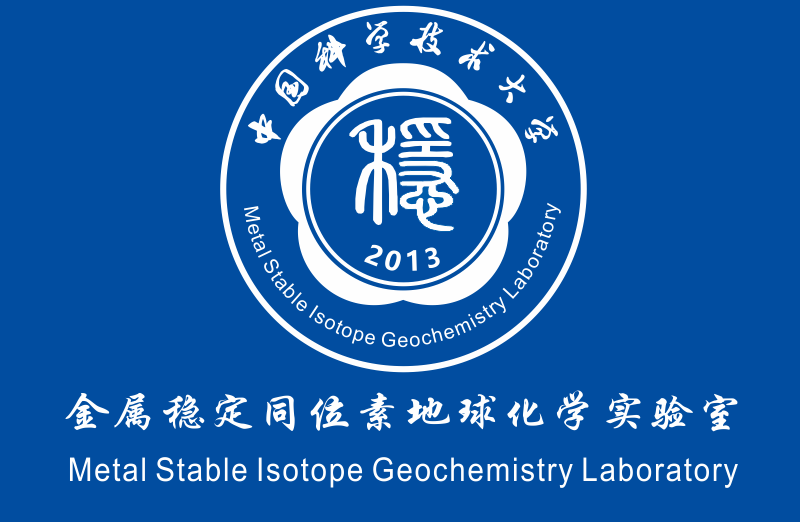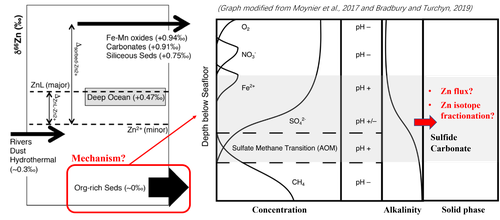

总访问量:



张兴超,Dec. 1, 2021
锌(Zn)是生命必须微量营养元素,对于生物体的碳(C)和磷(P)的代谢具有重要意义(Sinoir et al., 2012)。因此,Zn在海洋中的循环与C等主要营养元素循环和海洋初级生产力存在内在联系(Morel and Price, 2003; Moore et al., 2013)。随着质谱分析技术的发展,Zn同位素(δ66Zn)提供了认识现代大洋Zn循环的重要地球化学工具(Conway and John, 2014; Zhao et al., 2014; Conway and John, 2015; John et al., 2018; Vance et al., 2019; Wang et al., 2019; Lemaitre et al., 2020; Liao et al., 2020; Sieber et al., 2020; Liao et al., 2021)。同时,δ66Zn在碳酸盐岩等沉积记录中的变化,也能够作为潜在的古海洋环境变化的示踪剂(Pichat et al., 2003; Kunzmann et al., 2013; John et al., 2017; Liu et al., 2017; Isson et al., 2018; Lv et al., 2018; Sweere et al., 2018; Wang et al., 2018; Yan et al., 2019; Chen et al., 2021)。对现代大洋海水的观测结果显示,深层海水较为均匀的δ66Zn(~0.47‰)比所有海洋输入源(河流、大气和洋底热液等,δ66Zn~0.30‰)都要高,而比大多数氧化大洋沉积物(碳酸盐、铁-猛氧化物和硅质沉积等,δ66Zn > 0.70‰)都要低(Little et al., 2014; Moynier et al., 2017)。假设大洋的Zn循环处于稳态,这一显著的输入和输出的质量不平衡预示存在未知的源或汇未被发现。
对于大陆边缘高生产力区域的沉积物的观测结果显示,富有机质的沉积物具有较低的δ66Zn(Little et al., 2016; Zhang et al., 2021)。这一汇的组成和规模可能受到表层海水中Zn被生物利用或有机质颗粒吸附等过程的影响,并最终可能以硫化物的形式在沉积物中被固定(Little et al., 2016; Vance et al., 2016)。近期的淋滤实验研究显示,沉积物中的有机质组分具有相对全样更高的δ66Zn,而轻Zn同位素的赋存和埋藏与沉积物中的自生组分(硫化物或氧化物等)有关(Zhang et al., 2021)。然而,目前我们对Zn在早期成岩过程中的再分配过程和同位素组成变化认识仍然不够充分。对相关机理进行研究将有助于补足现代大洋Zn循环的缺口。
有机物在大洋沉积物中的氧化过程能够减缓还原性碳(C)的埋藏,对全球碳(C)和氧(O)循环以及地表氧逸度的变化具有重要影响(Berner, 1989; Kump and Arthur, 1999; Kump et al., 2011)。由于氧气向沉积物中的渗透距离有限,随着埋藏深度的增加,有机物的氧化过程将会由有氧呼吸向厌氧氧化转变,这一过程在大陆边缘高生产力区域尤其明显(Tromp et al., 1995; D’hondt et al., 2015)。而随着氧化物的逐渐消耗,有机物最终能够在产烷生物的分解下形成甲烷,并能够在释放过程中与其他氧化剂反应(Whiticar, 1999; Sivan et al., 2007)。有机物和甲烷的氧化过程最终将使得有机C转换为无机C。与此同时,有机物和甲烷的厌氧氧化与微生物硫酸盐还原过程息息相关(Kasten et al., 2003)。相关过程主要包括有机碎屑硫酸盐还原(2CH2O+SO42− → 2HCO3− +H+ +HS−)和甲烷厌氧氧化(CH4 +SO42− →HCO3− +HS− +H2O)。由于硫化亚铁等的沉淀能够促使孔隙水的pH升高,有利于无机C沉淀形成碳酸盐,沉积物中碳酸盐和硫化物的形成存在一定的耦合性(Soetaert et al., 2007; Bradbury et al., 2021)。
冷泉碳酸盐是硫酸盐驱动的甲烷厌氧氧化过程中形成的产物(Feng et al., 2018)。现代大洋深钻的数据统计显示,甲烷厌氧氧化过程形成的碳酸盐占沉积物中自生碳酸盐的比例可能超过70%,是重要的早期成岩过程中碳酸盐和硫化物形成过程(Bradbury and Turchyn, 2019)。因此,对冷泉碳酸盐以及硫化物组分进行Zn含量和同位素组成研究,将有助于我们更好的制约早期成岩过程中Zn与C和S的变化关系,帮助理解Zn的埋藏过程。同时,也能够帮助我们更好的解读碳酸盐岩这一重要地质沉积记录中的Zn同位素组成信息。
参考文献:
Berner R. A. (1989) Biogeochemical cycles of carbon and sulfur and their effect on atmospheric oxygen over Phanerozoic time. Glob. Planet. Change 1, 97–122.
Bradbury H. J. and Turchyn A. V. (2019) Reevaluating the carbon sink due to sedimentary carbonate formation in modern marine sediments. Earth Planet. Sci. Lett. 519, 40–49. Available at: https://doi.org/10.1016/j.epsl.2019.04.044.
Bradbury H. J., Turchyn A. V., Bateson A., Antler G., Fotherby A., Druhan J. L., Greaves M., Sevilgen D. S. and Hodell D. A. (2021) The Carbon-Sulfur Link in the Remineralization of Organic Carbon in Surface Sediments. Front. Earth Sci. 9, 1–15.
Chen X., Sageman B. B., Yao H., Liu S. A., Han K., Zou Y. and Wang C. (2021) Zinc isotope evidence for paleoenvironmental changes during Cretaceous Oceanic Anoxic Event 2. Geology 49, 412–416.
Conway T. M. and John S. G. (2015) ScienceDirect The cycling of iron , zinc and cadmium in the North East Pacific Ocean – Insights from stable isotopes. Geochim. Cosmochim. Acta 164, 262–283. Available at: http://dx.doi.org/10.1016/j.gca.2015.05.023.
Conway T. M. and John S. G. (2014) The biogeochemical cycling of zinc and zinc isotopes in the North Atlantic Ocean. Glob. Biogeochem. Cycles Res., 1111–1128.
D’hondt S., Inagaki F., Zarikian C. A., Abrams L. J., Dubois N., Engelhardt T., Evans H., Ferdelman T., Gribsholt B., Harris R. N., Hoppie B. W., Hyun J. H., Kallmeyer J., Kim J., Lynch J. E., Mckinley C. C., Mitsunobu S., Morono Y., Murray R. W., Pockalny R., Sauvage J., Shimono T., Shiraishi F., Smith D. C., Smith-Duque C. E., Spivack A. J., Steinsbu B. O., Suzuki Y., Szpak M., Toffin L., Uramoto G., Yamaguchi Y. T., Zhang G. L., Zhang X. H. and Ziebis W. (2015) Presence of oxygen and aerobic communities from sea floor to basement in deep-sea sediments. Nat. Geosci. 8, 299–304.
Feng D., Qiu J. W., Hu Y., Peckmann J., Guan H., Tong H., Chen C., Chen J., Gong S., Li N. and Chen D. (2018) Cold seep systems in the South China Sea: An overview. J. Asian Earth Sci. 168, 3–16.
Isson T. T., Love G. D., Dupont C. L., Reinhard C. T., Zumberge A. J., Asael D., Gueguen B., McCrow J., Gill B. C., Owens J., Rainbird R. H., Rooney A. D., Zhao M. Y., Stueeken E. E., Konhauser K. O., John S. G., Lyons T. W. and Planavsky N. J. (2018) Tracking the rise of eukaryotes to ecological dominance with zinc isotopes. Geobiology 16, 341–352.
John S. G., Helgoe J. and Townsend E. (2018) Biogeochemical cycling of Zn and Cd and their stable isotopes in the Eastern Tropical South Pacific. Mar. Chem. 201, 256–262. Available at: https://doi.org/10.1016/j.marchem.2017.06.001.
John S. G., Kunzmann M., Townsend E. J. and Rosenberg A. D. (2017) Zinc and cadmium stable isotopes in the geological record: A case study from the post-snowball Earth Nuccaleena cap dolostone. Palaeogeogr. Palaeoclimatol. Palaeoecol. 466, 202–208. Available at: http://dx.doi.org/10.1016/j.palaeo.2016.11.003.
Kasten S., Zabel M., Heuer V. and Hensen C. (2003) Processes and signals of nonsteady-state diagenesis in deep-sea sediments and their pore waters. In The South Atlantic in the late quaternary Springer. pp. 431–459.
Kump L. R. and Arthur M. A. (1999) Interpreting carbon-isotope excursions: Carbonates and organic matter. Chem. Geol. 161, 181–198.
Kump L. R., Junium C., Arthur M. A., Brasier A., Fallick A., Melezhik V., Lepland A., Črne A. E. and Luo G. (2011) Isotopic evidence for massive oxidation of organic matter following the great oxidation event. Science (80-. ). 334, 1694–1696.
Kunzmann M., Halverson G. P., Sossi P. A., Raub T. D., Payne J. L. and Kirby J. (2013) Zn isotope evidence for immediate resumption of primary productivity after snowball Earth. Geology 41, 27–30.
Lemaitre N., de Souza G. F., Archer C., Wang R. M., Planquette H., Sarthou G. and Vance D. (2020) Pervasive sources of isotopically light zinc in the North Atlantic Ocean. Earth Planet. Sci. Lett. 539, 116216. Available at: https://doi.org/10.1016/j.epsl.2020.116216.
Liao W.-H., Takano S., Tian H.-A., Chen H.-Y., Sohrin Y. and Ho T.-Y. (2021) Zn elemental and isotopic features in sinking particles of the South China Sea: Implications for its sources and sinks. Geochim. Cosmochim. Acta 314, 68–84. Available at: https://doi.org/10.1016/j.gca.2021.09.013.
Liao W. H., Takano S., Yang S. C., Huang K. F., Sohrin Y. and Ho T. Y. (2020) Zn Isotope Composition in the Water Column of the Northwestern Pacific Ocean: The Importance of External Sources. Global Biogeochem. Cycles 34, 1–18.
Little S. H., Vance D., McManus J. and Severmann S. (2016) Key role of continental margin sediments in the oceanic mass balance of Zn and Zn isotopes. Geology 44, 207–210.
Little S. H., Vance D., Walker-Brown C. and Landing W. M. (2014) The oceanic mass balance of copper and zinc isotopes, investigated by analysis of their inputs, and outputs to ferromanganese oxide sediments. Geochim. Cosmochim. Acta 125, 673–693. Available at: http://dx.doi.org/10.1016/j.gca.2013.07.046.
Liu S. A., Wu H., Shen S. Z., Jiang G., Zhang S., Lv Y., Zhang H. and Li S. (2017) Zinc isotope evidence for intensive magmatism immediately before the end-Permian mass extinction. Geology 45, 343–346.
Lv Y., Liu S. A., Wu H., Hohl S. V., Chen S. and Li S. (2018) Zn-Sr isotope records of the Ediacaran Doushantuo Formation in South China: diagenesis assessment and implications. Geochim. Cosmochim. Acta 239, 330–345. Available at: https://doi.org/10.1016/j.gca.2018.08.003.
Moore C. M., Mills M. M., Arrigo K. R., Berman-Frank I., Bopp L., Boyd P. W., Galbraith E. D., Geider R. J., Guieu C., Jaccard S. L., Jickells T. D., La Roche J., Lenton T. M., Mahowald N. M., Marañón E., Marinov I., Moore J. K., Nakatsuka T., Oschlies A., Saito M. A., Thingstad T. F., Tsuda A. and Ulloa O. (2013) Processes and patterns of oceanic nutrient limitation. Nat. Geosci. 6, 701–710.
Morel F. M. M. and Price N. M. (2003) The biogeochemical cycles of trace metals in the oceans. Science (80-. ). 300, 944–947.
Moynier F., Vance D., Fujii T. and Savage P. (2017) The isotope geochemistry of zinc and copper. Non-Traditional Stable Isot. 82, 543–600.
Pichat S., Douchet C. and Albarède F. (2003) Zinc isotope variations in deep-sea carbonates from the eastern equatorial Pacific over the last 175 ka. Earth Planet. Sci. Lett. 210, 167–178.
Sieber M., Conway T. M., de Souza G. F., Hassler C. S., Ellwood M. J. and Vance D. (2020) Cycling of zinc and its isotopes across multiple zones of the Southern Ocean: Insights from the Antarctic Circumnavigation Expedition. Geochim. Cosmochim. Acta 268, 310–324. Available at: https://doi.org/10.1016/j.gca.2019.09.039.
Sinoir M., Butler E. C. V., Bowie A. R., Mongin M., Nesterenko P. N. and Hassler C. S. (2012) Zinc marine biogeochemistry in seawater: A review. Mar. Freshw. Res. 63, 644–657.
Sivan O., Schrag D. P. and Murray R. W. (2007) Rates of methanogenesis and methanotrophy in deep-sea sediments. Geobiology 5, 141–151.
Soetaert K., Hofmann A. F., Middelburg J. J., Meysman F. J. R. and Greenwood J. (2007) Reprint of “The effect of biogeochemical processes on pH.” Mar. Chem. 106, 380–401.
Sweere T. C., Dickson A. J., Jenkyns H. C., Porcelli D., Elrick M., van den Boorn S. H. J. M. and Henderson G. M. (2018) Isotopic evidence for changes in the zinc cycle during Oceanic Anoxic Event 2 (Late Cretaceous). Geology 46, 463–466.
Tromp T. K., Van Cappellen P. and Key R. M. (1995) A global model for the early diagenesis of organic carbon and organic phosphorus in marine sediments. Geochim. Cosmochim. Acta 59, 1259–1284.
Vance D., Little S. H., Archer C., Cameron V., Andersen M. B., Rijkenberg M. J. A. and Lyons T. W. (2016) The oceanic budgets of nickel and zinc isotopes: The importance of sulfdic environments as illustrated by the Black Sea. Philos. Trans. R. Soc. A Math. Phys. Eng. Sci. 374.
Vance D., de Souza G. F., Zhao Y., Cullen J. T. and Lohan M. C. (2019) The relationship between zinc, its isotopes, and the major nutrients in the North-East Pacific. Earth Planet. Sci. Lett. 525, 115748. Available at: https://doi.org/10.1016/j.epsl.2019.115748.
Wang R. M., Archer C., Bowie A. R. and Vance D. (2019) Zinc and nickel isotopes in seawater from the Indian Sector of the Southern Ocean: The impact of natural iron fertilization versus Southern Ocean hydrography and biogeochemistry. Chem. Geol. 511, 452–464. Available at: https://doi.org/10.1016/j.chemgeo.2018.09.010.
Wang X., Liu S. A., Wang Z., Chen D. and Zhang L. (2018) Zinc and strontium isotope evidence for climate cooling and constraints on the Frasnian-Famennian (~372 Ma) mass extinction. Palaeogeogr. Palaeoclimatol. Palaeoecol. 498, 68–82. Available at: https://doi.org/10.1016/j.palaeo.2018.03.002.
Whiticar M. J. (1999) Carbon and hydrogen isotope systematics of bacterial formation and oxidation of methane. Chem. Geol. 161, 291–314.
Yan B., Zhu X., He X. and Tang S. (2019) Zn isotopic evolution in early Ediacaran ocean: A global signature. Precambrian Res. 320, 472–483. Available at: https://doi.org/10.1016/j.precamres.2018.11.021.
Zhang Y., Planavsky N. J., Zhao M., Isson T., Asael D., Wang C. and Wang F. (2021) The isotopic composition of sedimentary organic zinc and implications for the global Zn isotope mass balance. Geochim. Cosmochim. Acta 314, 16–26. Available at: https://doi.org/10.1016/j.gca.2021.09.009.
Zhao Y., Vance D., Abouchami W. and De Baar H. J. W. (2014) Biogeochemical cycling of zinc and its isotopes in the Southern Ocean. Geochim. Cosmochim. Acta 125, 653–672.